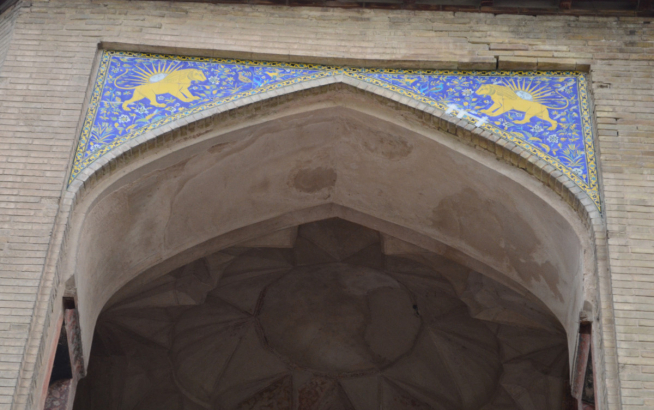Safavid Tile Arch Project III: The Palace of the Stables

Written by Lisa Golombek, Curator Emeritus (Islamic Art)
There are thousands of tiles from the Safavid period in Iran (16th-17th centuries), and many monuments of this period preserve their splendid tiling in their original settings. However, the ROM's Safavid Tile Arch Project (STAP) deals only with a series of arched panels that most likely came from a single secular building, and were made by a single workshop. One question we hope to answer is: what was that building?

Frontispiece from a Persian manuscript depicting a royal reception in a Safavid garden palace. Manuscript of "Akhlaq-i Muhsini" by Husayn Wa'iz Kashifi, Iran, paper, inscribed and painted, Safavid Period c. 1520 to 1530 AD, 22.8 x 15 cm, ROM #997.47.1
What we now know about the tile arches may give us a clue as to where they came from. There are at least 25 different scenes, and each of these existed in duplicate, making a total of at least 50 arches in this building. Sometimes we have two pairs almost complete. The pairs may have different background colours, but they were produced from the same cartoons. Tile workshops would normally re-use a cartoon any number of times, but these tile arches all seem to have had only one duplicate. We deduce from this that there were only two sets of these arches. Why two sets? We believe that they ran along the parallel walls of a long courtyard. The same scene would appear at the same point along the length of the two walls

In the Maydan, looking southwest with the Ali Qapu gate pavilion on the right and the blue tiled dome of the Royal Mosque (Masjid-i Shah, today called Masjid-i Imam) on the left (photo: L. Golombek 1966).
The tiles had certainly belonged to an important building, most likely a palace, and could not have been removed wholesale unless the building were deteriorating or being demolished. That is precisely what I think happened. We know that the Qajar governor of Isfahan from 1872 to 1907, Zill al-Sultan, destroyed much of the medieval urban fabric of Isfahan to erase all trace of the previous dynasty. One palace in particular is known to have met this fate—the Palace of the Royal Stables—which was situated just behind the monumental gate, the Ali Qapu, to what had been the royal Safavid precincts.

Studio Portrait of Zill al-Sultan, Governor of Isfahan (1850–1919), and the brother of Muzaffar al-Din Shah. One of 274 Vintage Photographs, late 19th-early 20th century. Albumen silver photograph, 9 3/4 x 6 1/4 in. (24.8 x 15.9 cm). Brooklyn Museum, Purchase gift of Leona Soudavar in memory of Ahmad Soudavar, 1997.3.117 (Photo: Brooklyn Museum, 1997.3.117_IMLS_PS3.jpg)
The arrangement of 50 arches would work in the building that is designated as the “Talar-i Tavileh” (Palace of the Royal Stables) as depicted on a planographic map of the royal precincts by the German naturalist Engelbert Kaempfer, who visited Isfahan in 1687. The palace was in use until the middle of the 19th century but had begun to deteriorate after that. One visitor commented in 1908 that he had seen “faience” among the ruins. I believe that these arches came from the arcade that enclosed the garden, at the end of which stood the magnificent pavilion where royal celebrations were held and foreign embassies were entertained.

View of Isfahan, drawn by German physician and naturalist, Engelbert Kaempfer, 1684 (Planografia, from his travelogue Amoenitatum). Talar-i Tavileh is highlighted.
Why “stables”? Surely this was not where the Shah kept his horses! But when Isfahan first became the Safavid capital in 1598, the stables were located here. They were moved to another site around 1635, when this pavilion was built. From then on it was the favoured venue for important events. European visitors report that they were led into the courtyard along a lush plane-tree covered pathway where magnificently caparisoned horses were tethered to stone mangers. All of their ornament, even the nails of their shoes, were made of gold. Then the visitors would proceed to the pavilion where they were wined and dined. Music and entertainment accompanied the feast.

Four tiles from a fragmentary tile frieze at the ROM which we call "The Grooms" (976,298.59, .76, .77, .78, & .79).
LINKS
Safavid Tile Arch Project I: The Technology
Safavid Tile Arch Project II: Rebuilding the Friezes
Wirth Gallery of the Middle East
Manuscript of "Akhlaq-i Muhsini" by Husayn Wa'iz Kashifi
